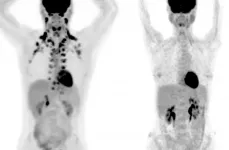(Press-News.org) PORTLAND, Ore. - Researchers at Oregon State University have found that a few organisms in the gut microbiome play a key role in type 2 diabetes, opening the door to possible probiotic treatments for a serious metabolic disease affecting roughly one in 10 Americans.
"Type 2 diabetes is in fact a global pandemic and the number of diagnoses is expected to keep rising over the next decade," said study co-leader Andrey Morgun, associate professor of pharmaceutical sciences in the OSU College of Pharmacy. "The so-called 'western diet' - high in saturated fats and refined sugars - is one of the primary factors. But gut bacteria have an important role to play in modulating the effects of diet."
Formerly known as adult-onset diabetes, type 2 diabetes is a chronic condition affecting the way the body metabolizes glucose, a sugar that's a key source of energy. For some patients, that means their body resists the effects of insulin - the hormone produced by the pancreas that opens the door for sugar to enter cells. Other patients don't produce enough insulin to maintain normal glucose levels.
In either case, sugar builds up in the bloodstream and if left untreated the effect is impairment to many major organs, sometimes to disabling or life-threatening degrees. A key risk factor for type 2 diabetes is being overweight, often a result of a western diet in combination with low physical activity.
The human gut microbiome features more than 10 trillion microbial cells from about 1,000 different bacterial species. Dysbiosis, or imbalance, in the microbiome is commonly associated with detrimental effects on a person's health.
"Some studies suggest dysbiosis is caused by complex changes resulting from interactions of hundreds of different microbes," said Natalia Shulzhenko, an associate professor of biomedical sciences in OSU's Carlson College of Veterinary Medicine and the study's other co-leader. "However, our study and other studies suggest that individual members of the microbial community, altered by diet, might have a significant impact on the host."
Shulzhenko and Morgun used a new, data-driven, systems-biology approach called transkingdom network analysis to study host-microbe interactions under a western diet. That allowed them to investigate whether individual members of the microbiota played a part in metabolic changes the diet induces in a host.
"The analysis pointed to specific microbes that potentially would affect the way a person metabolizes glucose and lipids," Morgun said. "Even more importantly, it allowed us to make inferences about whether those effects are harmful or beneficial to the host. And we found links between those microbes and obesity."
The scientists identified four operational taxonomic units, or OTUs, that seemed to affect glucose metabolism; OTUs are a means of categorizing bacteria based on gene sequence similarity.
The identified OTUs corresponded to four bacterial species: Lactobacillus johnsonii, Lactobacillus gasseri, Romboutsia ilealis and Ruminococcus gnavus.
"The first two microbes are considered potential 'improvers' to glucose metabolism, the other two potential 'worseners,'" Shulzhenko said. "The overall indication is that individual types of microbes and/or their interactions, and not community-level dysbiosis, are key players in type 2 diabetes."
The researchers fed mice the equivalent of a western diet and then supplemented the rodents' intake with the improver and worsener microbes. The Lactobacilli boosted mitochondrial health in the liver, meaning improvements in how the host metabolizes glucose and lipids, and the mice receiving those Lactobacilli also had a lower fat mass index than those fed only a western diet.
Checking the mouse results against data from an earlier human study, the scientists found correlations between human body mass index and abundance of the four bacteria - more of the improvers meant a better body mass index, more of the worseners was connected to a less healthy BMI.
"We found R. ilealis to be present in more than 80% of obese patients, suggesting the microbe could be a prevalent pathobiont in overweight people," Shulzhenko said.
A pathobiont is an organism that normally has a symbiotic relationship with its host but can become disease-causing under certain circumstances.
"Altogether, our observations support what we saw in the western diet-fed mice," she said. "And in looking at all of the metabolites, we found a few that explain a big part of probiotic effects caused by Lactobacilli treatments."
Lactobacillus is a microbial genus that contains hundreds of different bacterial strains. Its representatives are common among probiotics and frequently found in many types of fermented foods and Lactobacillus-fortified dairy products, such as yogurt.
"Our study reveals potential probiotic strains for treatment of type 2 diabetes and obesity as well as insights into the mechanisms of their action," Morgun said. "That means an opportunity to develop targeted therapies rather than attempting to restore 'healthy' microbiota in general."
INFORMATION:
The U.S. National Institutes of Health and the European Research Council supported this research. Findings were published in Nature Communications.
Researchers from the OSU Colleges of Science and College of Public Health and Human Sciences also collaborated on this study, as did scientists from the University of Vienna and the National Institutes of Health.
To make kefir, it takes a team. A team of microbes.
That's the message of new research from EMBL and Cambridge University's Patil group and collaborators, published in Nature Microbiology today. Members of the group study kefir, one of the world's oldest fermented food products and increasingly considered to be a 'superfood' with many purported health benefits, including improved digestion and lower blood pressure and blood glucose levels. After studying 15 kefir samples, the researchers discovered to their surprise that the dominant species of Lactobacillus ...
CORVALLIS, Ore. - Forest loss declined 18% in African nations where a new satellite-based program provides free alerts when it detects deforestation activities.
A research collaboration that included Jennifer Alix-Garcia of Oregon State University found that the Global Land Analysis and Discovery System, known as GLAD, resulted in carbon sequestration benefits worth hundreds of millions of dollars in GLAD's first two years.
Findings were published today in Nature Climate Change.
The premise of GLAD is simple: Subscribe to the system, launch a free web application, receive email alerts when the GLAD algorithm detects deforestation going on and then take action to save forests.
GLAD, launched in 2016, delivers alerts created ...
CHAMPAIGN, Ill. -- Cities only occupy about 3% of the Earth's total land surface, but they bear the burden of the human-perceived effects of global climate change, researchers said. Global climate models are set up for big-picture analysis, leaving urban areas poorly represented. In a new study, researchers take a closer look at how climate change affects cities by using data-driven statistical models combined with traditional process-driven physical climate models.
The results of the research led by University of Illinois Urbana Champaign engineer Lei Zhao are published in the journal Nature Climate Change.
Home to more than 50% of the world's population, cities experience more heat stress, water scarcity, air pollution ...
Brown fat is that magical tissue that you would want more of. Unlike white fat, which stores calories, brown fat burns energy and scientists hope it may hold the key to new obesity treatments. But it has long been unclear whether people with ample brown fat truly enjoy better health. For one thing, it has been hard to even identify such individuals since brown fat is hidden deep inside the body.
Now, a new study in Nature Medicine offers strong evidence: among over 52,000 participants, those who had detectable brown fat were less likely than their peers to suffer cardiac and metabolic conditions ranging from type 2 diabetes to coronary artery disease, which ...
Amsterdam, NL, January 4, 2021 - The impact of the COVID-19 pandemic on children with disabilities has not received much attention, perhaps because the disease disproportionately affects older individuals. In this special issue of the Journal of Pediatric Rehabilitation Medicine experts assess the impact of the pandemic on pediatric patients with special needs, their caregivers, and healthcare providers. They also focus on the growing importance of telemedicine and provide insights and recommendations for mitigating the impact of the virus in the short and long term.
"Pediatric rehabilitation patients frequently ...
TAMPA, Fla. -- Prostate cancer is one of the most common cancers among men in the U.S. For many patients, hormone therapy is a treatment option. This type of therapy, also called androgen deprivation therapy (ADT), reduces the level of testosterone and other androgens in the body. Lowering androgen levels can make prostate cancer cells grow more slowly or shrink tumors over time. However, patients receiving ADT often experience higher levels of fatigue, depression and cognitive impairment.
Moffitt Cancer Center researchers are investigating whether inflammation ...
PROVIDENCE, R.I. [Brown University] -- Sea ice is a critical indicator of changes in the Earth's climate. A new discovery by Brown University researchers could provide scientists a new way to reconstruct sea ice abundance and distribution information from the ancient past, which could aid in understanding human-induced climate change happening now.
In a study published in Nature Communications, the researchers show that an organic molecule often found in high-latitude ocean sediments, known as tetra-unsaturated alkenone (C37:4), is produced by one or more previously unknown species of ice-dwelling algae. As sea ice concentration ebbs and flows, so do the algae associated with it, as well as the molecules ...
An emerging type of alloy nanoparticle proves more stable, durable than single-element nanoparticles.
Catalysts are integral to countless aspects of modern society. By speeding up important chemical reactions, catalysts support industrial manufacturing and reduce harmful emissions. They also increase efficiency in chemical processes for applications ranging from batteries and transportation to beer and laundry detergent.
As significant as catalysts are, the way they work is often a mystery to scientists. Understanding catalytic processes can help scientists develop more efficient and cost-effective catalysts. In a recent study, scientists from University of Illinois Chicago (UIC) and the U.S. Department of Energy's ...
A team working with Roland Fischer, Professor of Inorganic and Metal-Organic Chemistry at the Technical University Munich (TUM) has developed a highly efficient supercapacitor. The basis of the energy storage device is a novel, powerful and also sustainable graphene hybrid material that has comparable performance data to currently utilized batteries.
Usually, energy storage is associated with batteries and accumulators that provide energy for electronic devices. However, in laptops, cameras, cellphones or vehicles, so-called supercapacitors are increasingly installed these days.
Unlike batteries they can quickly store large amounts of energy and put it out just as fast. ...
Forgive Asiatic black bear if they're not impressed with their popular giant panda neighbors.
For decades, conservationists have preached that panda popularity, and the resulting support for their habitat, automatically benefits other animals in the mountainous ranges. That logic extends across the world, as animals regarded as cute, noble or otherwise appealing drum up support to protect where they live.
Yet in Biological Conservation, scientists take a closer look at how other animals under the panda "umbrella" fare and find several species have every reason to be ticked at panda-centric ...





